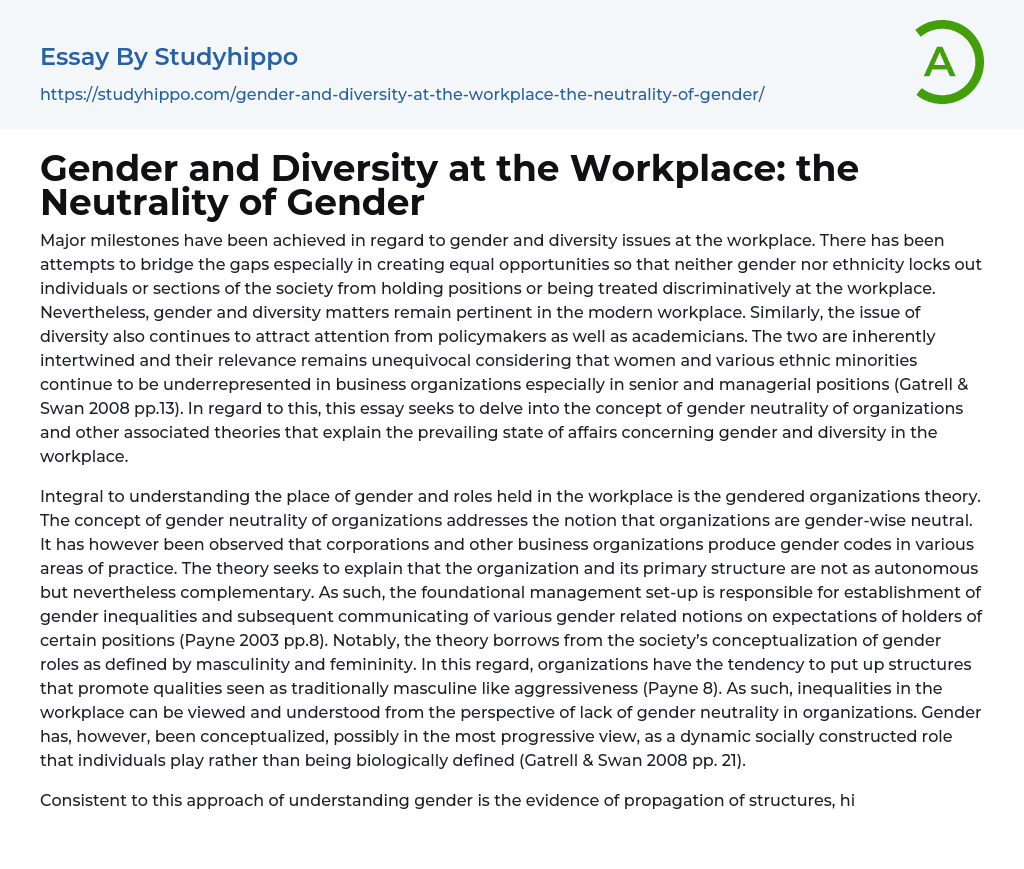

Gender and Diversity at the Workplace: the Neutrality of Gender Essay Example
Despite significant advancements in tackling gender and diversity issues in the workplace, the focus on bridging gaps and promoting equal opportunities for individuals of all genders and ethnicities remains relevant. Current attention from policymakers and academics underscores the significance of diversity.
The interconnectedness of gender and diversity remains crucial, as women and ethnic minorities continue to face underrepresentation in senior positions within business organizations (Gatrell & Swan 2008 pp.13). This essay aims to explore the idea of gender neutrality in organizations and related theories that explain the current state of gender and diversity in the workplace. Key to understanding the role of gender in the workplace is the gendered organizations theory. The concept of gender neutrality suggests that organizations are neutral in terms of gender. However, it has been observed that businesses generate gender codes in different aspects of their operations.
The th
...eory aims to clarify that the organization and its main structure are interdependent yet complementary. Therefore, the basic management framework plays a role in creating gender inequalities and perpetuating gender-related beliefs about the expectations for certain positions (Payne 2003 pp.8). Importantly, this theory draws upon societal ideas about gender roles based on masculinity and femininity. Consequently, organizations often establish structures that cultivate traditionally masculine traits such as aggressiveness (Payne 8).
The text emphasizes that workplace inequalities can be attributed to the lack of gender neutrality in organizations. It suggests that gender should be perceived as a socially constructed role rather than being biologically determined. This viewpoint highlights the existence of structures, hierarchies, and cultures within public and private organizations that perpetuate societal expectations of gender roles. To achieve a more accurate understanding of gender, it i
crucial to separate it from biological orientation.
Community practices and beliefs shape gender perceptions, leading individuals to conform to these views. Organizations adopt and integrate these perspectives into their culture and practices. Diversity can be understood in various ways, but in organizational management, it mainly entails actively embracing social and demographic groups from the community or society while advancing equal opportunities.
Encouraging and providing meaningful opportunities for marginalized groups, including those based on race, disability, gender, sexuality, and age, to participate in organizational management is crucial. Moreover, women have encountered more obstacles than men in achieving executive or managerial roles. The notion of masculinity represents societal expectations concerning acceptable conduct for men such as aggressiveness, heterosexuality, and independence. Organizational culture contributes to the perpetuation of this socially constructed concept. Masculinity is rooted in the belief that men gain respect by serving as the main providers and protectors of their families.
According to Acker (1990 pp.145), masculinity is deeply ingrained in society and culture, portraying men in positions of power as deserving of respect and instilling a sense of self-respect for lower-ranking males. This perpetuates power dynamics within corporate structures, with even subordinates playing a role in maintaining this hierarchy (Mumby 2013 pp.225).
Critical feminism, on the other hand, takes into account the significance of gender in organizational operations and existence. It recognizes that an organization's culture, deliberately established by its leadership, can favor or disadvantage certain individuals based on their gender. In essence, critical feminism highlights the fact that organizations are not gender neutral.
According to Acker (1990 pp.139), attempts to address gender-based inequalities and discriminatory practices must acknowledge the lack of gender neutrality in organizations. These efforts should recognize
that organizations have been structured in ways that favor masculinity. In environments where roles are divided by gender, the relationships and communication channels within an organization send signals about which positions or responsibilities are considered masculine or feminine (Mumby 2013 pp.227). As a result, individuals in these positions feel obligated to conform to these gender expectations, which is known as gender accountability (Mumby 2013 pp.).
218). Gender becomes encoded within an organization and is conveyed through metaphors, symbols, and language, shaping the routine life of the organization (Gatrell ; Swan 2008 pp.21). This communication of gendered signals continues even without the knowledge of the staff and management. Consequently, roles and expectations for different positions become deeply ingrained within both the management and the staff.
The organizational culture and hierarchy within a company reflect gender communication. When certain positions are deemed to be more effectively performed by a particular gender, it promotes gender inequality within the organization. This can be seen in the symbolism that portrays men as being in charge of success while women are relegated to subordinate roles. These stereotypes perpetuate a cultural sense of justification for power being concentrated in one gender. Importantly, the organization intentionally maintains its culture and power distribution to foster a productive and profitable environment.
The idea that gender is a societal construct that can change over time is more important than any other understanding of gender, including its connection to biological sex. While positions and responsibilities in organizations can be influenced by gender, this is reinforced by the organizational structure and established culture.
References
- Gatrell, C., ; Swan, E. (2008). Gender and Diversity in Management : A Concise Introduction. Lancaster: Sage Publications.
- Mumby,
D. K. (2013). Organizational communication: A critical approach.
Thousand Oaks: SAGE.
The article titled "HIERARCHIES, JOBS, BODIES: A Theory of Gendered Organizations" by (1990) was published in the journal Gender & Society. It is in volume 4, issue 2, and the page range is from 139 to 158. The article has a DOI: 10.1177/089124390004002002.



